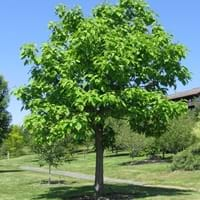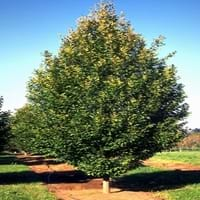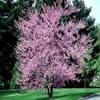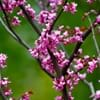Life Span
Perennial
Perennial
Origin
United States, Southeastern United States, Central United States
Europe, Eastern Europe, Southern Europe, Western Europe, Turkey
Types
not available
Not Available
Habitat
Moist woods, Swamps, Woodlands
Hedge, Woodland Garden Canopy
USDA Hardiness Zone
4-8
4-8
Sunset Zone
2a, 2b, 3a, 3b, 4, 5, 6, 7, 8, 9, 10, 11, 12, 13, 14, 15, 16, 17, 18, 19, 20, 21, 22, 23, 24
2a, 2b, 3a, 3b, 4, 5, 6, 7, 8, 9, 14, 15, 16, 17
Habit
Spreading
Oval or Rounded
Flower Color
White, Yellow, Purple
Yellow, Green
Flower Color Modifier
Bicolor
Bicolor
Fruit Color
Green, Brown
Yellow, Green, Brown
Leaf Color in Spring
Light Green
Green, Light Green
Leaf Color in Summer
Light Green
Green, Dark Green
Leaf Color in Fall
Yellow green, Brown
Yellow, Yellow green, Orange Red
Leaf Color in Winter
Not Available
Not Available
Leaf Shape
Heart-shaped
Ovate and toothed
Plant Season
Spring, Summer, Fall
Summer, Fall, Winter
Sunlight
Full Sun, Partial Sun, Partial shade
Full Sun, Partial Sun, Partial shade
Type of Soil
Clay, Loam
Clay, Loam
The pH of Soil
Acidic, Neutral, Alkaline
Acidic, Neutral
Soil Drainage
Well drained
Average
Tolerances
Wet Site, Drought
Pollution, Drought
Where to Plant?
Ground
Ground
How to Plant?
Stem Planting
Seedlings
Plant Maintenance
Low
Medium
Watering Requirements
Keep ground moist
Requires regular watering
In Summer
Lots of watering
Lots of watering
In Spring
Moderate
Moderate
In Winter
Average Water
Average Water
Soil pH
Acidic, Neutral, Alkaline
Acidic, Neutral
Soil Type
Clay, Loam
Clay, Loam
Soil Drainage Capacity
Well drained
Average
Sun Exposure
Full Sun, Partial Sun, Partial shade
Full Sun, Partial Sun, Partial shade
Pruning
Remove damaged leaves, Remove dead branches, Remove dead leaves
Remove dead or diseased plant parts
Fertilizers
Apply 10-10-10 amount, Do not let fertilizers touch the leaves, Doesn't require fertilization when grown in rich soil
All-Purpose Liquid Fertilizer
Pests and Diseases
Anthracnose, Brown Rot, Caterpillars, fungus, Sawfly Larvae, Verticillium Wilt
Aphids, Coral Spot, Powdery mildew
Plant Tolerance
Drought, Wet Site
Drought
Flowers
Showy
Insignificant
Flower Petal Number
Single
Not Available
Foliage Texture
Coarse
Medium
Foliage Sheen
Glossy
Glossy
Attracts
Not Available
Caterpillar, Not Available
Allergy
Skin irritation
Pollen
Aesthetic Uses
Showy Purposes
Bonsai
Beauty Benefits
Not Available
Not Available
Environmental Uses
Air purification
Air purification
Medicinal Uses
Not Available
Bach, Haemostatic, Ophthalmic
Part of Plant Used
Whole plant, Wood
Bark, Leaves, Wood
Other Uses
Used as Ornamental plant, Used for woodware, Used in Furniture
Used as fuel, Used to make yellow dye
Used As Indoor Plant
No
Yes
Used As Outdoor Plant
Yes
Yes
Garden Design
Feature Plant, Shade Trees, Street Trees
Feature Plant, Hedges, Screening / Wind Break, Shade Trees, Street Trees
Botanical Name
CATALPA speciosa
CARPINUS betulus
Common Name
Northern Catalpa
European Hornbeam
In Hindi
Northern Catalpa
European Hornbeam
In German
Northern Catalpa
Hainbuche
In French
Nord Catalpa
Hornbeam européenne
In Spanish
Catalpa Norte
Europeo carpe
In Greek
Βόρεια Catalpa
Ευρωπαϊκή Γαύρος
In Portuguese
Northern Catalpa
Carpino Europeia
In Polish
Północnej Catalpa
Europejski Grab
In Latin
Northern Catalpa
Carpinus betulus
Phylum
Magnoliophyta
Magnoliophyta
Class
Magnoliopsida
Magnoliopsida
Order
Scrophulariales
Fagales
Family
Bignoniaceae
Betulaceae
Clade
Angiosperms, Asterids, Eudicots
Angiosperms, Eudicots, Rosids
Tribe
Not Available
Carpineae
Subfamily
Not Available
Coryloideae
Number of Species
Not Available
Not Available
Season and Care of Northern Catalpa and European Hornbeam
Season and care of Northern Catalpa and European Hornbeam is important to know. While considering everything about Northern Catalpa and European Hornbeam Care, growing season is an essential factor. Northern Catalpa season is Spring, Summer and Fall and European Hornbeam season is Spring, Summer and Fall. The type of soil for Northern Catalpa is Clay, Loam and for European Hornbeam is Clay, Loam while the PH of soil for Northern Catalpa is Acidic, Neutral, Alkaline and for European Hornbeam is Acidic, Neutral.
Northern Catalpa and European Hornbeam Physical Information
Northern Catalpa and European Hornbeam physical information is very important for comparison. Northern Catalpa height is 1,220.00 cm and width 610.00 cm whereas European Hornbeam height is 1,220.00 cm and width 910.00 cm. The color specification of Northern Catalpa and European Hornbeam are as follows:
Northern Catalpa flower color: White, Yellow and Purple
Northern Catalpa leaf color: Light Green
European Hornbeam flower color: Yellow and Green
- European Hornbeam leaf color: Green and Light Green
Care of Northern Catalpa and European Hornbeam
Care of Northern Catalpa and European Hornbeam include pruning, fertilizers, watering etc. Northern Catalpa pruning is done Remove damaged leaves, Remove dead branches and Remove dead leaves and European Hornbeam pruning is done Remove dead or diseased plant parts. In summer Northern Catalpa needs Lots of watering and in winter, it needs Average Water. Whereas, in summer European Hornbeam needs Lots of watering and in winter, it needs Average Water.





